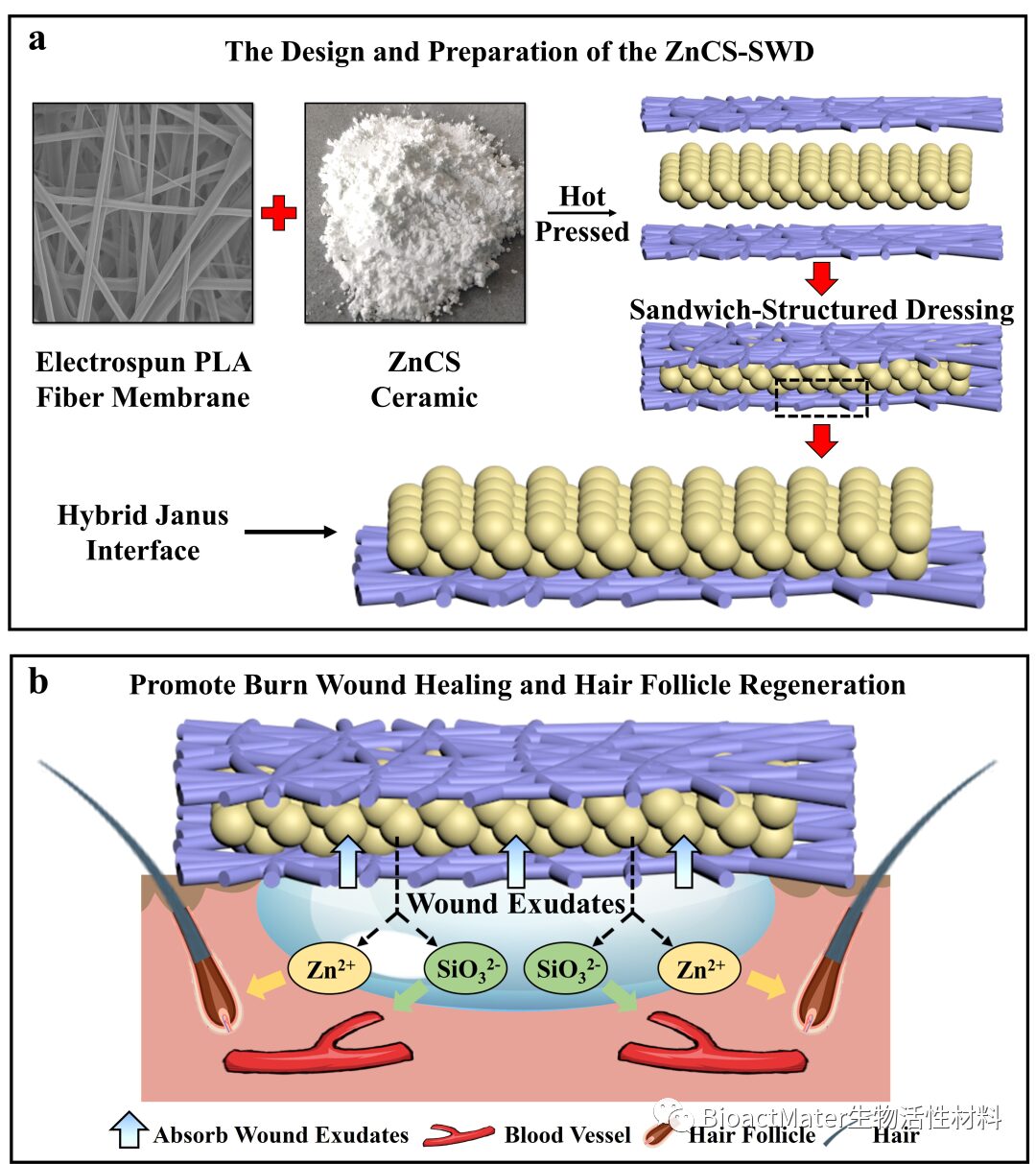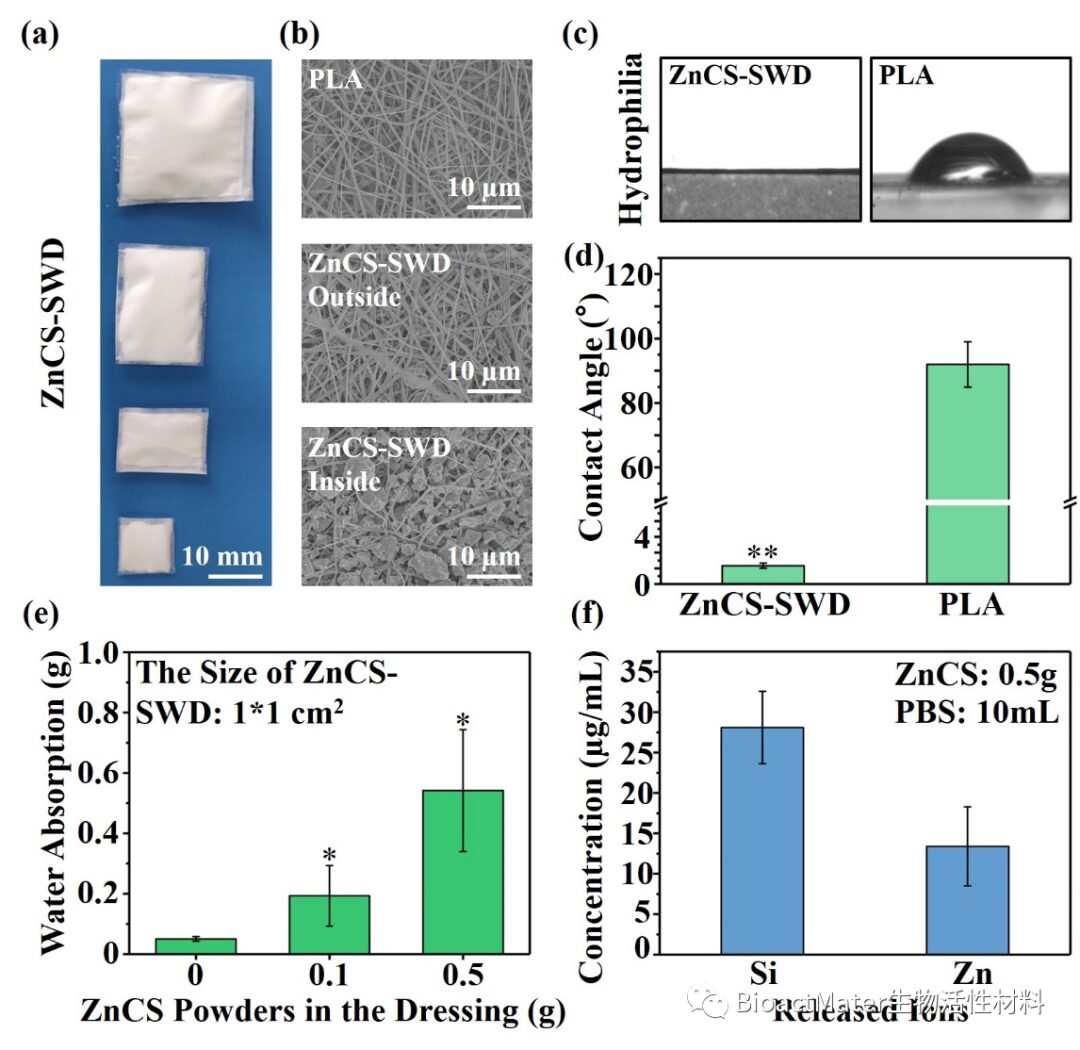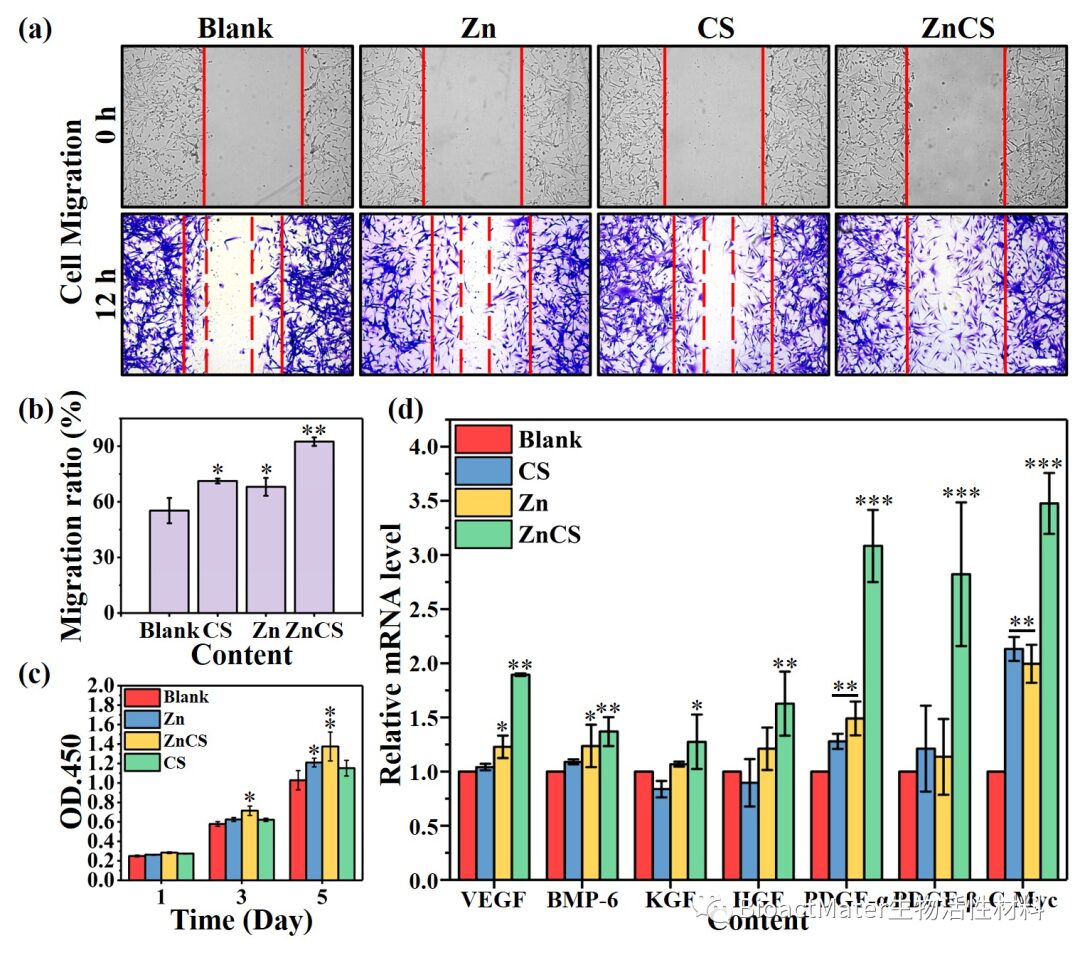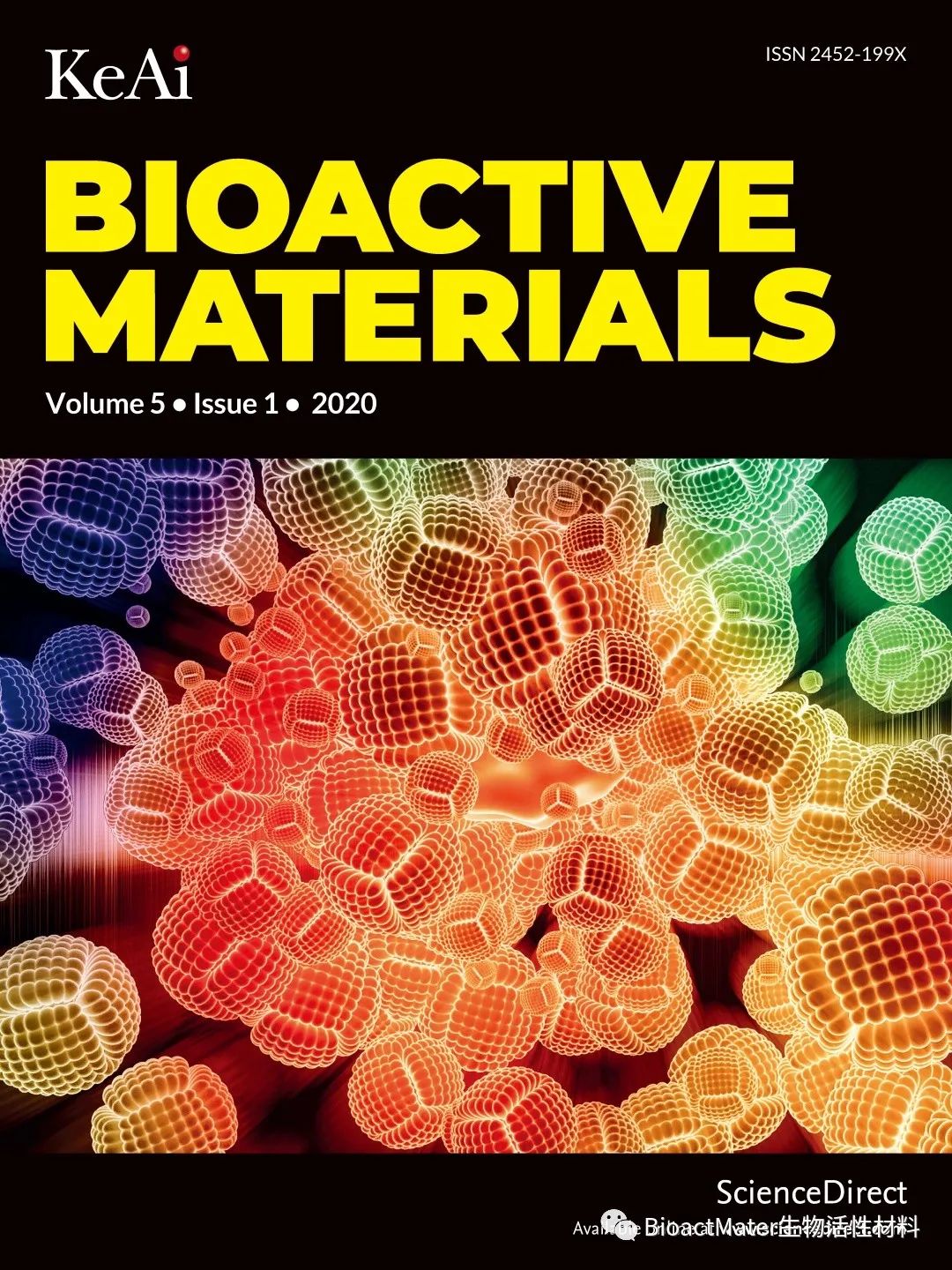After deep skin burns, the dermis is severely damaged, accompanied by a large amount of wound exudate, making it difficult for the wound to heal and damaging hair follicle tissue. This study combines hydrophilic zinc silicate bioceramics and hydrophobic polylactic acid (PLA) to create a sandwich-structured wound dressing (SWD) with Janus membrane characteristics, which exhibits excellent exudate absorption properties. Additionally, the incorporated zinc silicate endows the dressing with bioactivity that promotes wound healing.
01
Research Overview
Hair follicles are located in the dermis and are one of the main appendages of the skin. However, when the skin suffers from deep burns, both the epidermis and dermis are damaged, leading to the loss of hair follicle tissue beneath the dermis, which is difficult to regenerate. Damage to hair follicle tissue slows down the rate of skin re-epithelialization and significantly affects the appearance and function of the skin. At the same time, severe burns are often accompanied by a large amount of wound exudate, which can hinder the healing process and lead to infection. Previous studies on skin burn wound dressings (such as colloidal gels, nanomaterials, etc.) have typically focused on the antibacterial and anti-inflammatory functions of the materials. Few studies have focused on the regeneration of functional skin appendages such as hair follicles. There are also no wound dressings with dual functions of unidirectional exudate absorption and promoting hair follicle growth. Therefore, developing a wound dressing to address these two issues is of significant clinical importance.
In recent years, natural algae have become one of the most popular active substances in the cosmetic and pharmaceutical industries due to their excellent potential to enhance skin vitality and activate hair follicle tissue. Natural algae are aquatic unicellular organisms mainly composed of various algal species such as diatoms, cyanobacteria, and red algae. Previous studies have shown that algal extracts have wound healing properties and stimulate hair follicle activity. Interestingly, algal extracts contain many trace elements, including abundant Zn and Si.
Zn ions are an essential trace element in the development of hair follicles. They are necessary cofactors for more than 300 enzymes, such as alkaline phosphatase, dopamine tautomerase, metallothionein, and metalloproteinases, which play important functional roles in hair follicles, indicating that the content of Zn ions in the human body is closely related to the state of hair follicles. For example, adequate Zn intake can significantly prolong the regression of hair follicles caused by apoptosis in the treatment of androgenetic alopecia; wound dressings containing Zn can significantly promote the growth of hair follicle tissue at the wound site. Recently, Si ions have been shown to significantly promote angiogenesis, activate skin healing-related specific gene expression, stimulate endothelial cell proliferation and migration, and enhance vascularization in early damaged areas. Moreover, many studies have confirmed that different ions can produce special synergistic effects, promoting the regeneration and repair of various tissues. These findings suggest that the active factors of natural algae extracts in repairing damaged skin are likely closely related to the synergistic effects of Zn and Si ions.
Bioceramics are among the most effective materials for achieving efficient release of various ions. Their good moisture absorption can easily provide a dry environment for the wound. However, due to the sharp nature of ceramic powders, direct application on the wound can cause adhesion to the wound surface, leading to thickening and hardening of the repaired wound. Additionally, the exudate from the wound may cause the loss of ceramic particles, limiting their application in skin wound repair.
Janus membranes are a class of materials with one side hydrophobic and the other side hydrophilic. This structure allows aqueous solutions to be transported unidirectionally from the hydrophobic side to the hydrophilic side. Utilizing this structure can remove exudate from the wound surface, providing a dry environment for the wound. It is well known that most silicate bioceramic powders have good hydrophilicity. Therefore, we hypothesized that if a layer of silicate bioceramic particles is combined with a hydrophobic polymer fiber membrane, the resulting hybrid interface may possess the function of a Janus interface, allowing exudate to be transported unidirectionally upward while the ceramic powder absorbs the exudate that has been transported up. Based on this consideration, we designed a sandwich-structured wound dressing (ZnCS-SWD) by wrapping hydrophilic zinc silicate bioceramics (Hardystonite, ZnCS) with a hydrophobic polymer fiber membrane (PLA) (Fig.1). This structure can unidirectionally expel excess biological fluid from the wound, ensuring that the wound surface remains dry and clean, while also avoiding potential damage to the wound from direct contact with sharp ceramic powders. Furthermore, by absorbing the large amount of exudate produced by burn wounds, the dressing can efficiently and stably release high-activity Zn and Si ions to promote burn wound healing and hair follicle regeneration.

Fig. 1. A biofluid absorbing sandwich-structured wound dressing (SWD) designed by organic-inorganic hybrid Janus membrane containing hardystonite (ZnCS, Ca2ZnSi2O7) and the application in deep burn wound healing with enhanced hair growth and angiogenesis. (The wound fluid is absorbed by the powder in the sandwich dressing, which then releases bioactive ions for stimulating the regeneration of blood vessels and hair follicles.) (a) The design and preparation of the ZnCS-SWD. (b) ZnCS-SWD promotes burn wound healing and hair follicle regeneration.
Experimental results show that ZnCS-SWD indeed possesses good water absorption and releases Zn ions (13.40 ± 4.89ppm) and Si ions (28.11 ± 4.48ppm), both within the bioactive range (Fig.2).

Fig. 2. Material characterization of ZnCS sandwich-structured wound dressing (ZnCS-SWD) (PLA fiber membrane was used for comparison). (a) The macroscopic appearance of the ZnCS-SWD. (b) The SEM of the ZnCS-SWD (Outside: the side not in contact with the ceramic powders; Inside: the side directly in contact with the ceramic powders). (c) Photos of the water contact angle of the ZnCS-SWD surface. (d) Quantitation of the contact angle of the ZnCS-SWD. (e) The water absorption performance of the ZnCS-SWD (1*1 cm2) with different amounts of bioceramic powders. (f) The ion release of the ZnCS-SWD (1*1 cm2) by soaking in PBS at 37°C for 24 hours.
Moreover, ZnCS-SWD can effectively treat deep skin burns. It also promotes the repair of vascular tissue, hair follicle tissue, and epithelial tissue (Fig.3 and Fig.4).

Fig. 3. (a) Establishment of a burn animal model using a hot metal iron bar and use sandwich-structured wound dressing for treatment. (b) Wound closure after treatment with sandwich-structured wound dressing. Wound area images on the 0th, 3rd, 10th, 17th, and 24th day after treatment with different materials (blank was treated with PLA dressings). (c) Quantitation of wound closure rate of composite membranes (n = 4). (d) Images of H&E staining of wound sections on the 10th and 24th day (BW: Burn wound; NE, newly formed epidermis; ND, newly formed dermis; HF, newly formed hair follicle). *P < 0.05 and **P < 0.01.

Fig. 4. (a) Images of immunohistochemical staining for cytokeratin 19 on the 10th and 24th day (HF, newly formed hair follicles). (b) Number of hair follicles on the 24th day (n = 6). (c) Images of immunohistochemical staining for CD31 on the 10th and 24th day (BV, blood vessels). (d) Number of blood vessels on the 10th and 24th day. (e) Vessel diameter distribution on the 24th day. (* P < 0.05, ** P < 0.01, n=3).
The main reason for the good therapeutic effect of ZnCS-SWD may be the special synergistic effect produced by the released Zn and Si ions, which promote the activity and migration of hair follicle dermal papilla cells. At the same time, it enhances the expression of genes related to hair follicle growth (Fig.5).

Fig. 5. Synergistic effect of Zn and Si ions on the migration, viability and gene expression of hair follicle dermal papilla cells (HHDPCs) (1/16 ZnCS extracts were used as Zn and Si ions solution. CS extracts (CS) and Zinc chloride solution (Zn) with the same concentration were used as control groups). (a) The synergistic effect of Zn and Si ions on the migration of HHDPCs cells (Ruler Length = 200µm). (b) Migration rate of HHDPCs. (c) The synergistic effect of Zn and Si ions on the viability of HHDPCs. (d) The synergistic effect of Zn and Si ions on genes (VEGF, BMP-6, KGF, HGF, PDGF-α, PDGF-β, and C-Myc) related to hair follicle growth in HHDPCs (* P < 0.05, ** P < 0.01, *** P < 0.001).
In conclusion, in this study, we constructed an organic-inorganic composite Janus membrane by wrapping hydrophobic PLA fiber membranes around hydrophilic ZnCS ceramic particles. This sandwich-structured wound dressing can effectively absorb wound exudate while releasing Zn and Si bioactive ions, synergistically promoting rapid wound healing and inducing hair follicle regeneration. The synergistic effects of Zn and Si effectively stimulated the cell activity, migration, and differentiation capabilities of hair follicle dermal papilla cells. Our research indicates that the combination of hydrophilic inorganic layers with hydrophobic organic layers can also form Janus membranes with unidirectional fluid transport capabilities, and the combination of different types of functional ions may possess synergistic bioactivity that promotes tissue regeneration.
02
Authors’ Information
First Author: Zhaowenbin Zhang
PhD, Shanghai Institute of Ceramics, Chinese Academy of Sciences, research direction is biomaterials for treating soft tissue injuries.
Corresponding Author: Jiang Chang
PhD, researcher and doctoral supervisor at Shanghai Institute of Ceramics, Chinese Academy of Sciences. Mainly engaged in research on tissue regeneration and repair materials, interaction between biomaterials and cells, has published over 400 academic papers, cited over 19,000 times, authored 11 chapters in English monographs, edited 2 English monographs, and holds over 60 authorized invention patents.
03
Funding Information
The above research work was supported by the National Key Research and Development Program (2016YFC1100201), National Natural Science Foundation (81772078, 81671830), and Shanghai Science and Technology Commission (19441902300).
04
Original Paper Information
Zhaowenbin Zhang#, Wenbo Li#, Ying Liu, Zhigang Yang, Lingling Ma, Hui Zhuang, Endian Wang, Chengtie Wu, Zhiguang Huan, Feng Guo∗, Jiang Chang∗.
Design of a biofluid-absorbing bioactive sandwich-structured Zn–Si bioceramic composite wound dressing for hair follicle regeneration and skin burn wound healing.
Bioactive Materials 6 (2021) 1910-1920.
Click to read the original text for details

Bioactive Materials is a high-quality English journal that has been indexed by SCIE, PubMed Central, Scopus, Embase. The journal was also selected for the 2019 China Science and Technology Journal Excellence Action Plan – “High Starting Point New Journal” project.
In 2020, Bioactive Materials received its first impact factor of 8.724, ranking second in the field of Materials Science and Biomaterials.
It is listed in the 1st District of the “2020 Journal Classification Table of the Chinese Academy of Sciences Literature and Information Center”, a TOP journal.
